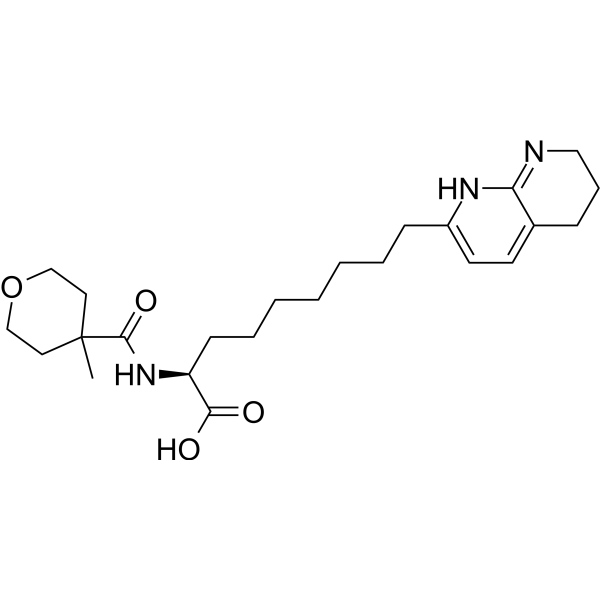Physicochemical Properties
| Molecular Formula | C24H37N3O4 |
| Molecular Weight | 431.57 |
| Exact Mass | 431.278 |
| CAS # | 2408065-32-5 |
| PubChem CID | 146483463 |
| Appearance | Off-white to light yellow solid powder |
| Density | 1.23±0.1 g/cm3(Predicted) |
| Boiling Point | 716.5±60.0 °C(Predicted) |
| LogP | 4.2 |
| Hydrogen Bond Donor Count | 3 |
| Hydrogen Bond Acceptor Count | 6 |
| Rotatable Bond Count | 11 |
| Heavy Atom Count | 31 |
| Complexity | 579 |
| Defined Atom Stereocenter Count | 1 |
| SMILES | CC1(CCOCC1)C(=O)N[C@@H](CCCCCCCC2=NC3=C(CCCN3)C=C2)C(=O)O |
| InChi Key | GELVLHVQVRSFAY-FQEVSTJZSA-N |
| InChi Code | InChI=1S/C24H37N3O4/c1-24(13-16-31-17-14-24)23(30)27-20(22(28)29)10-6-4-2-3-5-9-19-12-11-18-8-7-15-25-21(18)26-19/h11-12,20H,2-10,13-17H2,1H3,(H,25,26)(H,27,30)(H,28,29)/t20-/m0/s1 |
| Chemical Name | (2S)-2-[(4-methyloxane-4-carbonyl)amino]-9-(5,6,7,8-tetrahydro-1,8-naphthyridin-2-yl)nonanoic acid |
| HS Tariff Code | 2934.99.9001 |
| Storage |
Powder-20°C 3 years 4°C 2 years In solvent -80°C 6 months -20°C 1 month |
| Shipping Condition | Room temperature (This product is stable at ambient temperature for a few days during ordinary shipping and time spent in Customs) |
Biological Activity
| Targets | IC50: <50 nM (ανβ1), <50 nM (ανβ6)[1] |
| ln Vitro | In a solid phase experiment, PLN-1474 inhibits αvβ1 and ανβ6 with IC50s of ≤50 nM[1]. |
| ln Vivo | Profibrotic genes, such as COL1A1 and TIMP1, have lower expression levels in the liver when exposed to 10 μM of PLN-1474[1]. In a mouse model of liver fibrosis, PLN-1474 dramatically lowers the levels of pSMAD3/SMAD3 in the liver, hepatic collagen gene expression, and hepatic OHP concentration[1]. PLN-1474 (6–12 weeks) dramatically lowers OHP levels, collagen gene expression, and collagen deposition assessed histologically in the CDAHFD NASH animal model. It also prevents or treats SMAD3 phosphorylation[1]. |
| References |
[1]. Combination treatment of liver diseases using integrin inhibitors. WO2021127483. 2021. |
Solubility Data
| Solubility (In Vitro) | DMSO : ≥ 83.33 mg/mL (193.09 mM) |
| Solubility (In Vivo) |
Note: Listed below are some common formulations that may be used to formulate products with low water solubility (e.g. < 1 mg/mL), you may test these formulations using a minute amount of products to avoid loss of samples. Injection Formulations (e.g. IP/IV/IM/SC) Injection Formulation 1: DMSO : Tween 80: Saline = 10 : 5 : 85 (i.e. 100 μL DMSO stock solution → 50 μL Tween 80 → 850 μL Saline) *Preparation of saline: Dissolve 0.9 g of sodium chloride in 100 mL ddH ₂ O to obtain a clear solution. Injection Formulation 2: DMSO : PEG300 :Tween 80 : Saline = 10 : 40 : 5 : 45 (i.e. 100 μL DMSO → 400 μLPEG300 → 50 μL Tween 80 → 450 μL Saline) Injection Formulation 3: DMSO : Corn oil = 10 : 90 (i.e. 100 μL DMSO → 900 μL Corn oil) Example: Take the Injection Formulation 3 (DMSO : Corn oil = 10 : 90) as an example, if 1 mL of 2.5 mg/mL working solution is to be prepared, you can take 100 μL 25 mg/mL DMSO stock solution and add to 900 μL corn oil, mix well to obtain a clear or suspension solution (2.5 mg/mL, ready for use in animals). Injection Formulation 4: DMSO : 20% SBE-β-CD in saline = 10 : 90 [i.e. 100 μL DMSO → 900 μL (20% SBE-β-CD in saline)] *Preparation of 20% SBE-β-CD in Saline (4°C,1 week): Dissolve 2 g SBE-β-CD in 10 mL saline to obtain a clear solution. Injection Formulation 5: 2-Hydroxypropyl-β-cyclodextrin : Saline = 50 : 50 (i.e. 500 μL 2-Hydroxypropyl-β-cyclodextrin → 500 μL Saline) Injection Formulation 6: DMSO : PEG300 : castor oil : Saline = 5 : 10 : 20 : 65 (i.e. 50 μL DMSO → 100 μLPEG300 → 200 μL castor oil → 650 μL Saline) Injection Formulation 7: Ethanol : Cremophor : Saline = 10: 10 : 80 (i.e. 100 μL Ethanol → 100 μL Cremophor → 800 μL Saline) Injection Formulation 8: Dissolve in Cremophor/Ethanol (50 : 50), then diluted by Saline Injection Formulation 9: EtOH : Corn oil = 10 : 90 (i.e. 100 μL EtOH → 900 μL Corn oil) Injection Formulation 10: EtOH : PEG300:Tween 80 : Saline = 10 : 40 : 5 : 45 (i.e. 100 μL EtOH → 400 μLPEG300 → 50 μL Tween 80 → 450 μL Saline) Oral Formulations Oral Formulation 1: Suspend in 0.5% CMC Na (carboxymethylcellulose sodium) Oral Formulation 2: Suspend in 0.5% Carboxymethyl cellulose Example: Take the Oral Formulation 1 (Suspend in 0.5% CMC Na) as an example, if 100 mL of 2.5 mg/mL working solution is to be prepared, you can first prepare 0.5% CMC Na solution by measuring 0.5 g CMC Na and dissolve it in 100 mL ddH2O to obtain a clear solution; then add 250 mg of the product to 100 mL 0.5% CMC Na solution, to make the suspension solution (2.5 mg/mL, ready for use in animals). Oral Formulation 3: Dissolved in PEG400 Oral Formulation 4: Suspend in 0.2% Carboxymethyl cellulose Oral Formulation 5: Dissolve in 0.25% Tween 80 and 0.5% Carboxymethyl cellulose Oral Formulation 6: Mixing with food powders Note: Please be aware that the above formulations are for reference only. InvivoChem strongly recommends customers to read literature methods/protocols carefully before determining which formulation you should use for in vivo studies, as different compounds have different solubility properties and have to be formulated differently. (Please use freshly prepared in vivo formulations for optimal results.) |
| Preparing Stock Solutions | 1 mg | 5 mg | 10 mg | |
| 1 mM | 2.3171 mL | 11.5856 mL | 23.1712 mL | |
| 5 mM | 0.4634 mL | 2.3171 mL | 4.6342 mL | |
| 10 mM | 0.2317 mL | 1.1586 mL | 2.3171 mL |
